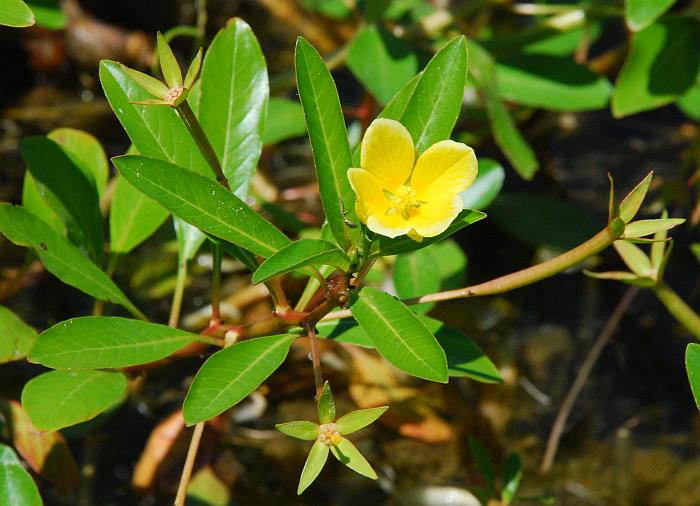Ludwigia peploides (Kunth) P.H. Raven
Floating Primrose Willow

Native
CC = 3
CW = -5
MOC = 56
© SRTurner
Ludwigia peploides (Kunth) P.H. RavenFloating Primrose Willow | |
 |
Native CC = 3 CW = -5 MOC = 56 |
© SRTurner |
|
Family - Onagraceae Habit - Fibrous-rooted perennial forb, emergent to floating aquatic.
Stem - To 1.5 m, floating on water or creeping on mud, occasionally loosely ascending toward the tip, rooting at the lower nodes, mostly rounded slightly succulent, often reddish, glabrous or emergent stems sometimes with scattered hairs toward the tip.
Leaves - Alternate, the petioles 20-45 mm long. Stipules 0.6-1.6 mm long, ovate-triangular to nearly semicircular or rarely 3-lobed. Leaf blades glabrous, usually shiny, those of the floating leaves 2-3 cm long, 7-23 mm wide, broadly elliptic to broadly oblanceolate, broadly obovate, or nearly circular, tapered at the base, rounded to bluntly pointed at the tip; those of emergent leaves 3-8 cm long, 4-40 mm wide, narrowly oblong or narrowly elliptic to ovate, obovate, circular, or oblanceolate, angled or tapered at the base, angled or slightly tapered to a pointed tip, often with a minute glandular extension of the midvein at the very tip, the margins entire, the venation pinnate, but the inconspicuous secondary veins more or less fused to form a submarginal vein.
Calyx - Sepals 5, 8-12 mm long, 1.5-4.0 mm wide, narrowly to broadly lanceolate, angled or slightly tapered to a sharply pointed tip.
Flowers - On stalks 10-60 mm long (elongating in fruit), the bractlets 0.5-2.0 mm long, ovate-triangular, green or reddish-tinged. Petals 5, 9-15 mm long, 4-13 mm wide, obovate, broadly rounded to truncate or with a shallow notch at the tip, yellow. Stamens 10 in 2 unequal whorls, the filaments yellow, the anthers 0.8-1.4 mm long.
Fruit - Fruit stalks 35-90 mm long. Capsules 20-40 mm long, 3-5 mm wide, cylindric or nearly so, often somewhat curved, usually bluntly 5-angled in cross-section, truncate at the tip and narrowed abruptly at the base, thick-walled and often slightly woody, glabrous, dehiscing tardily and irregularly. Seeds 1.0-1.3 mm long, oblong-cylindric, firmly embedded in wedge-shaped pieces of woody fruit tissue.
Flowering - May - October. Habitat - Ponds, swamps, sloughs, marshes, slow-moving water. Origin - Native to the U.S. Lookalikes - Other members of the Ludwigia genus. Other info. - This species is common across most of Missouri. Though apparently missing from the central Ozark region, this omission is likely due to undercollection rather than absence. The plant's U.S. distribution extends in a wide Midwestern band from Iowa down to the Gulf of Mexico. Where found, it can be very abundant and will sometimes cover pond margins with rampant growth. The bright yellow flowers can make for a showy display, although the petals of this and other Ludwigia species are easily lost and may not persist long in windy conditions. The stems are internally spongy and easily broken. Photographs taken at Busch Wildlife Area, St. Charles County, MO, 6-28-2009; at Marais Temps Clair Conservation Area, St. Charles County, MO, 8-17-2012; and in Creve Coeur Lake County Park, St. Louis County, MO, 9-26-2019 (SRTurner). |